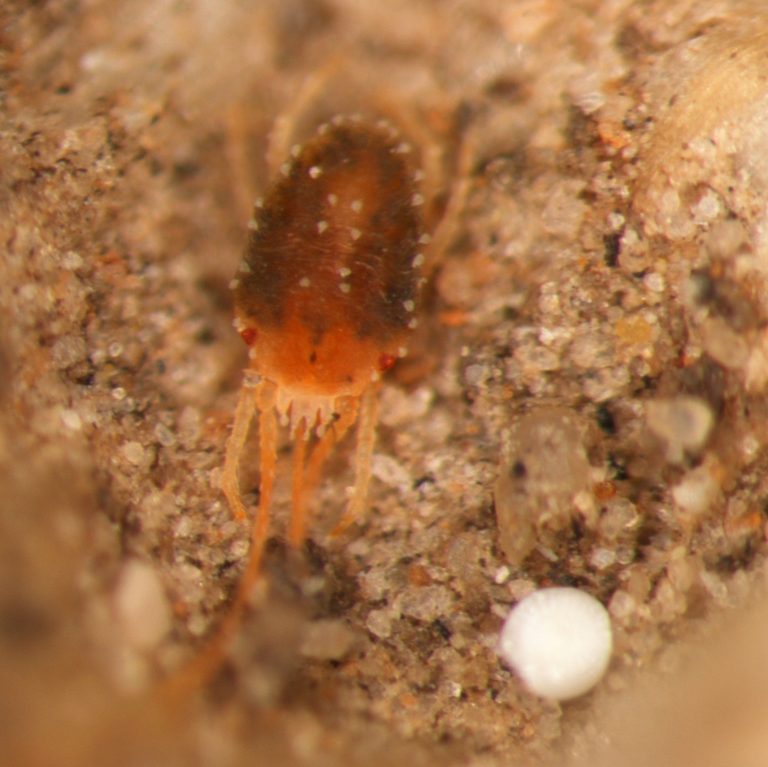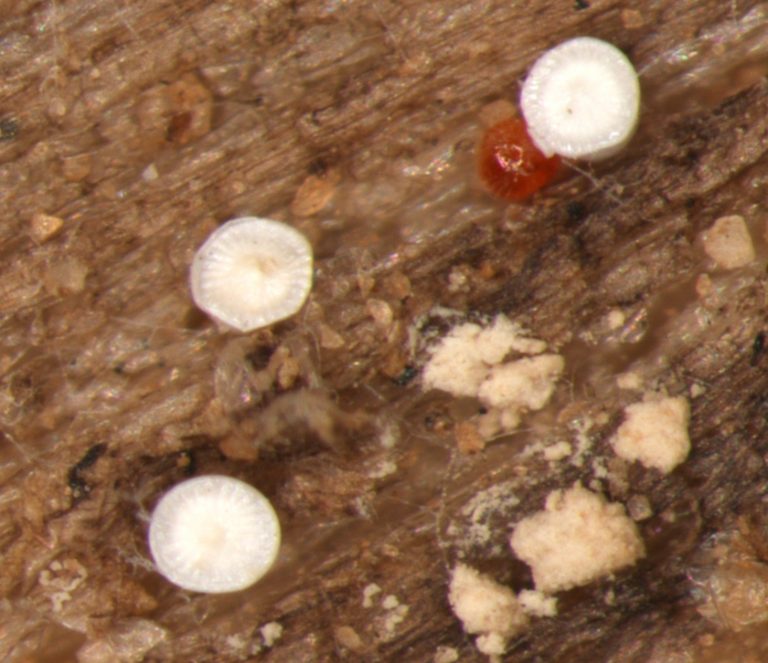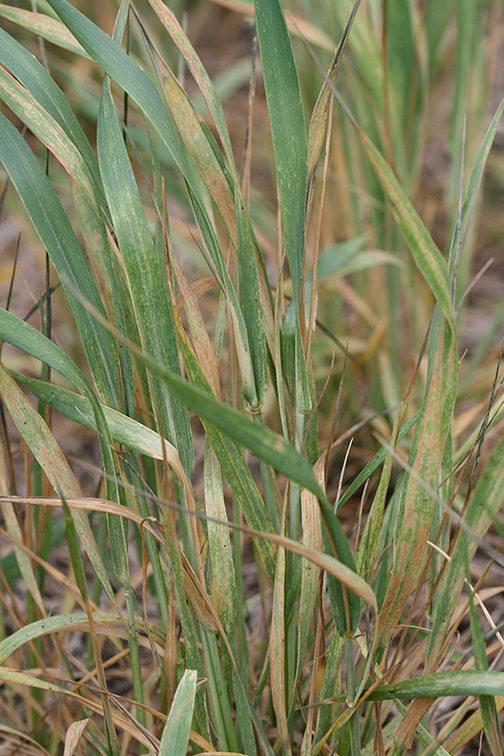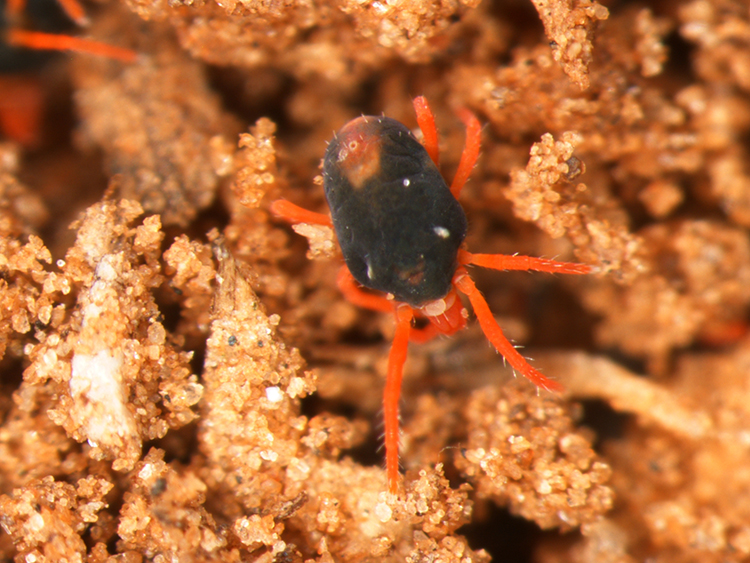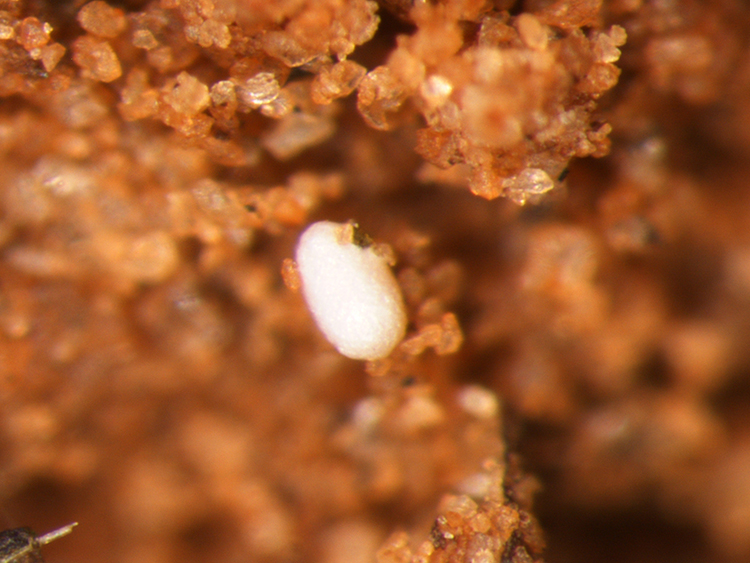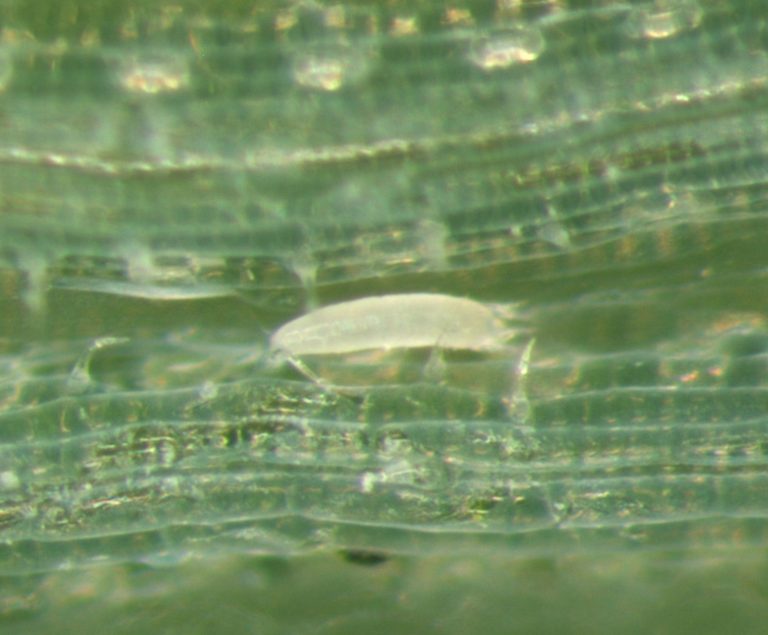Mites in Small Grains
Mites
Mites are not insects, but are closely related to spiders and ticks. Some mites are predaceous, while others are plant feeders. Three plant-feeding mites are commonly found on winter wheat in Oklahoma, occasionally injuring wheat crops. Each mite has a specific biology and different strategies are required to effectively manage them.
Brown Wheat Mite (Petrobia latens)
The brown wheat mite occurs statewide, but is more common in the western and panhandle counties. Brown wheat mites are about the size of a period on newsprint (less than 1/50 inch). They have dark brown bodies with four pairs of light brown to yellow legs. The forelegs are twice as long as the remaining 3 pairs (Figure 1).
Figure 1. Brown Wheat Mite (BWM).
This mite spends the summer as a dormant, white egg, which hatches in the fall (Figure 2). These mites feed and adults produce red eggs that hatch in about seven days at 72 F. From fall through spring there are multiple generations, each cycling about 21 days, depending on temperatures. Population numbers generally peak in spring. Females of the last generation lay white eggs in the soil that will diapause through the summer and hatch the following fall.
Figure 2. Brown Wheat Mite (BMW) eggs.
Brown wheat mites are more prevalent during dry weather, and injury symptoms can be confused with drought stress. They feed by piercing plant cells in the leaf, resulting in “stippling.” Wheat plants infested with brown wheat mites appear scorched or bronzed and withered (Figure 3). Brown wheat mite activity is greatest in the afternoon on warm days. An easy way to inspect for brown wheat mite is to shake some plants onto a white piece of paper, making the mites easy to observe.
Figure 3. Brown Wheat Mite (BWM) Damage.
This mite is more often a problem with continuous wheat production systems. Crop rotation with canola can be an effective deterrent. Precipitation and temperature can affect brown wheat mite buildup. Rainfall of greater than 0.25 inch will often reduce mite populations and plant stress. Research suggests a treatment threshold of 25 to 50 brown wheat mites per leaf in wheat that is 6 inches to 9 inches tall is economically warranted. An alternative estimation is “several hundred” per foot of row. While there are effective acaricides registered to control the brown wheat mite, these acaricides are often less effective when plants are drought stressed. For current acaricide recommendations, consult Extension Fact Sheet EPP-7194 Management of Insect and Mite Pests of Small Grains.
Winter Grain Mite (Penthaleus major)
The winter grain mite is commonly found throughout the state, except for the panhandle. It is slightly larger than the brown wheat mite, measuring 1/32 inch to 1/16 inch. It has a dark blue to black body and has orange-red legs and an orange or red spot on the upper abdomen (Figure 4). The front pair of legs are slightly longer than the other three pair.
Figure 4. Winter Grain Mite (WGM).
Winter grain mites spend the summer as kidney-shaped eggs, typically attached to leaf blades or soil, that hatch in the fall (Figure 5). There are two generations, the first beginning in fall and the second from eggs laid in January and February. In all cases, the mites are female, which can lay eggs cycling about 21 days, depending on temperature. Winter grain mites thrive under wet, cool conditions and populations decline with warmer temperatures.
Figure 5. Winter Grain Mite (WGM) Eggs.
This mite is associated with continuous wheat production systems. Wheat fields infested with winter grain mites take on a silvery-gray color and the leaf tips may turn brown, and plants may become stunted (Figure 6). Winter grain mites are more visible on cloudy days or in the morning or evening. They hide under clods or just beneath the soil crust during daylight hours. An easy way to inspect for winter grain mite is to shake some plants onto a white piece of paper, making them easy to observe. During the day, use a magnifying glass to inspect the base of wheat plants and under dirt clods. Control is not usually required, but there are effective acaricides available. An acaricide treatment should be considered when plants show visible injury and mites are still present. For current acaricide recommendations, consult Extension Fact Sheet EPP 7194 Management of Insect and Mite Pests of Small Grains.
Figure 6. Winter Grain Mite (WGM) damage.
Wheat Curl Mite (Aceria tosichella)
The wheat curl mite occurs throughout Oklahoma, but is more prevalent west of Interstate 35. The wheat curl mite is a whitish colored, sausage-shaped mite measuring about 1/100 inch and has two pair of legs located near the head (Figure 7).
Figure 7. Wheat Curl Mite (WCM)
Wheat curl mites prefer to feed on terminal leaves and the most tender leaf tissue, and will move to newly emerging leaves. They lay eggs along leaf veins. Under optimal conditions (75 F to 85 F), wheat curl mites can complete a generation in 10 days. As they feed, they cause the outer margins of leaves to roll up and the mites reside within those tight rolls. When plants begin to dry down, they move to the flag leaf or head and are carried by the wind to their over-summering grass hosts. The reverse occurs when their summer hosts dry down — they move back to wheat. Besides winter wheat, wheat curl mite feeds on maize and several weed grasses including western wheatgrass, jointed goatgrass, sandbur, Canada wildrye, barnyard grass, stinkgrass, witchgrass and green foxtail
The mites can be seen with a 10X magnifying lens by carefully unrolling the leaves. While the physical damage from their feeding can cause problems, the most important damage are the vectors of viruses they carry causing Wheat streak mosaic (WSM), High plains disease (HPD) and Triticum mosaic (TrM). All three diseases can cause severe problems when infections are heavy. For more information on these mite transmitted virus diseases, consult Extension Fact Sheet EPP-7328: Wheat Streak Mosaic, High Plains Disease and Triticum Mosaic: Three Virus Diseases of Wheat in Oklahoma.
Unfortunately, chemical control options for wheat curl mite are not effective. Management options include destruction of volunteer wheat AT LEAST TWO WEEKS PRIOR TO PLANTING, planting later in the fall and selecting WSM resistant varieties. Wheat varieties resistant to WSM and other diseases are listed in Extension Fact Sheet PPS-2142 2012: Wheat Variety Comparison.
Tom A Royer
Extension Entomologist

